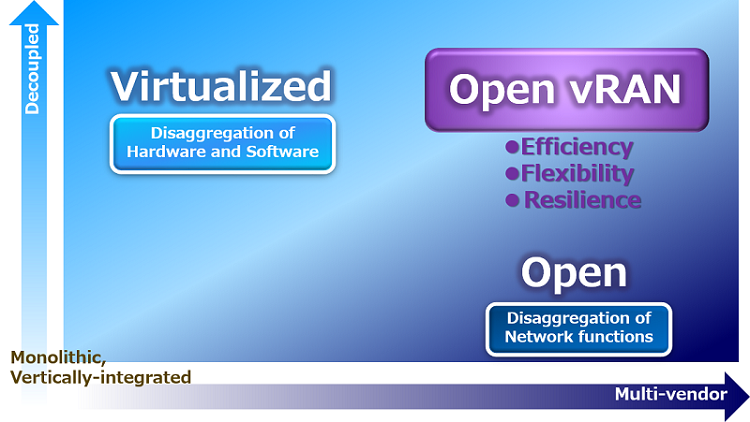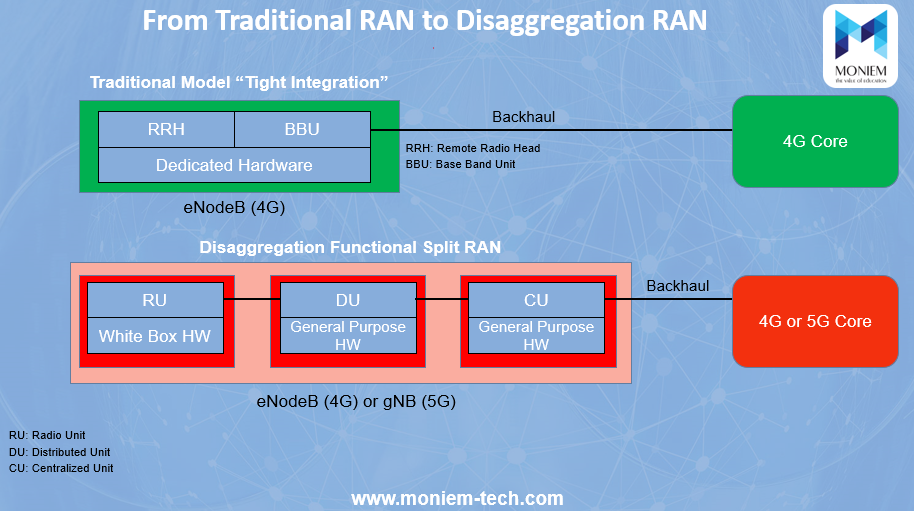There are different acronyms related to the evolution of RAN (Radio Access Network), like vRAN, open RAN, O-RAN, etc. A key point to clarify is that RAN evolution means both the disaggregation of mobile network base stations into more standardized entities (this is widely known as functional split), as well as the introduction of cloud technology to enable automated deployment and scaling and to optimize the location of workloads.
So Let’s say that Disaggregation or functional aggregation is the first step towards RAN Evolution. that means eNodeB in 4G or gNB in 5G should be disaggregated into three modules or functions RU/DU/CU.
There are two vectors to disaggregating the Radio Access Networks (RAN). One is the horizontal disaggregation of the network functions (RU/DU/CU) with open interfaces, defined as Open RAN. The other is the vertical disaggregation of hardware and software with virtualization technologies or vRAN.

Both horizontal and vertical disaggregation combined is defined as Open vRAN or an Open and Virtualized RAN. These dynamics will bring tremendous advantages to the CSPs, by opening doors to a diverse, innovative selection of products as well as enabling the implementation of a more scalable, intelligent, and resilient network that can significantly increase the flexibility and efficiency of CSPs deployments and operations.
What is vRAN or virtual RAN?
Virtualized radio access networks (vRANs) are a way for telecommunications operators to run their baseband functions as software. One of the primary benefits of virtualizing radio access networks (RANs) is that RAN functions no longer require special proprietary hardware to run, and can instead be run on standard servers. This is achieved by applying the principles of virtualization to RAN and is usually one part of a larger network function virtualization (NFV) effort.

What are the benefits of vRAN?
Many carriers have lowered their costs and created a more agile infrastructure by deploying a variety of virtual network functions (VNFs), including virtual firewalls, DNS, SBC/IMS, virtual evolved packet cores (vEPCs) for 4G networks, and vRANs.
This approach:
- Uses less (and less expensive) hardware.
- Increases flexibility.
- Provides the ability to spin workloads up and down with minimal effort.
- Allows resources to be scaled elastically to address changing network demands.
What is “Open RAN”?
According to Mavenir, the definition of “Open RAN” is “RAN (Radio Access Network) with separate functions built based on the open interface specifications. Vendor-neutral hardware and software based on the open interface and standard specifications. It can be implemented using software technology.
Open RAN enables the disaggregation and integration of the RAN components based on open specifications, allowing flexibility to combine best-of-breed components from a diversified supply chain to efficiently and effectively accommodate various use cases.
In other words, Open RAN in a broad sense refers to separating radio access networks into elements based on open specifications so that they can be used in combination. According to this definition, Open RAN can utilize virtualization technology like Rakuten’s network, but it can be said that it is not a necessary condition to satisfy the definition of Open RAN.
What is “O-RAN”?
Regarding the definition of “O-RAN”, It refers to the O-RAN Alliance or the specifications developed by the same organization”. From there, it can be said that O-RAN refers to the activities of the industry group “O-RAN Alliance”, which will be described later, or the specifications established by the group, especially in Open RAN.
From the above, the differences between Open RAN and O-RAN, which have similar words, are as follows. Open RAN is a term that refers to a general concept, and O-RAN is a term that refers to the activities and specifications of a particular organization.
Virtualized RAN is not necessarily an Open RAN. Virtualized RAN simply implies the vendor has virtualized its RAN components such as baseband unit, gNB, eNodeB, distributed unit (DU), and central unit (CU) – but their components do not necessarily comply with O-RAN specifications, nor can you mix and match these components from different vendors.
